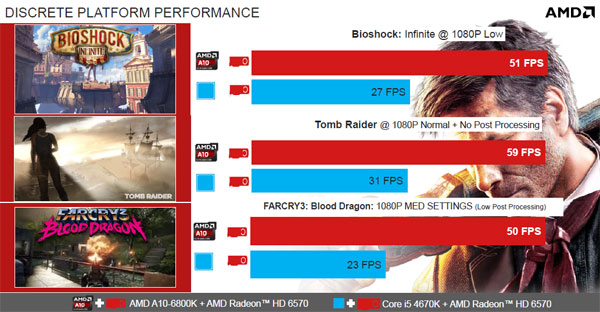AMD A10-6700 And A10-6800K Review: Richland Hits The Desktop
Richland, code name for AMD's highest-end APUs, finds its way into our lab in the form of A10-6700 and A10-6800K. Based on the Piledriver architecture and VLIW4 graphics, these chips are slight improvements to Trinity. Can they outshine Core i3, though?
AMD Dual Graphics: Not Ready For Benchmark Results
AMD’s Dual Graphics technology, once referred to as Hybrid CrossFire, allows the APU to work cooperatively with a discrete graphics card to deliver higher game frame rates than either component flying solo. At first glance, this seems like a great way to extract value, offering an upgrade path not available on any competing platform.
Unfortunately, there are limitations. First, this is a software-based capability that only works with DirectX 10 and 11 game engines. Second, the APU is quickly outclassed by most discrete cards. So it really only works with Radeon HD 6450, 6570, and 6670 boards, maintaining balance between the two parts.
We've long since wanted to dig deeper into Dual Graphics; after all, as you can see in the screen capture above, AMD claims it serves up a serious performance increase. But in our subjective experience, this feature does not necessarily appear to yield smoother game play. For the company's Richland introduction, we were excited to finally test Dual Graphics using our FCAT tools, capturing the raw display output and analyzing the stream to determine if frames were being dropped entirely or rendered in a series of full and tiny (runt) frames.
Unfortunately, our video-based analysis turned up an unexpected issue that prevents us from reporting the performance of Dual Graphics. Intermittently, we'd see a frame rendered, followed by a piece of the following frame, a piece of the original frame, and the rest of the following frame. This artifact is accompanied by a tear across the screen as Dual Graphics puts the two frames together.
It's consequently impossible to run our FCAT analysis on the output, since the frame sequence can't be measured. Fraps-based testing in this case would clearly be inaccurate. So, it's better to hold off on trying to quantify the performance of Dual Graphics until AMD can provide a solution that composites the frames free from artifacts or tears. The company is aware of our findings and is working to address them. As of yet, though, we don't have an explanation of why this is happening.
Get Tom's Hardware's best news and in-depth reviews, straight to your inbox.
Current page: AMD Dual Graphics: Not Ready For Benchmark Results
Prev Page Richland APUs Make Their Way To The Desktop Next Page Test Setup And BenchmarksDon Woligroski was a former senior hardware editor for Tom's Hardware. He has covered a wide range of PC hardware topics, including CPUs, GPUs, system building, and emerging technologies.
-
esrever Numbering has never been for the architecture inside the chips. They have always been marketing for the current line of products. Normal people buy a laptop, they see the number, they get the performance associated with said number and they don't care about the inside of the chip. Richland is just a trinity refresh with better power management and higher clocks.Reply -
-Fran- No temps with power metrics page? 8(Reply
I guess Richland is still very hot going by the power figures alone. Still, it's a good step up (and stop gap) for AMD.
Nice review still. Are you guys planning on a follow up for Dual Graphics? 8)
Cheers! -
Wes Young Reply10920935 said:This is dumb. Still 6670 max card for dual graphics. Disappointing.
No, since driver 13.1 even the 5800k was able to run dual graphics with a HD 7750. I am typing on a system with that exact setup right now. I am not sure if the 6800k will allow anything above the 7750 though. When I tried a 7770 with the 5800k I wasn't given the option to enable dual graphics.

